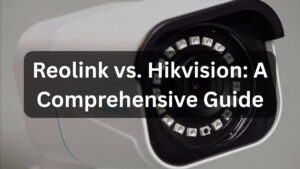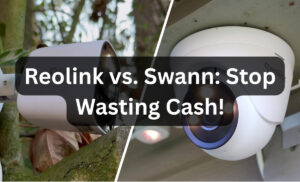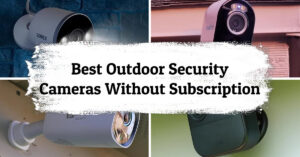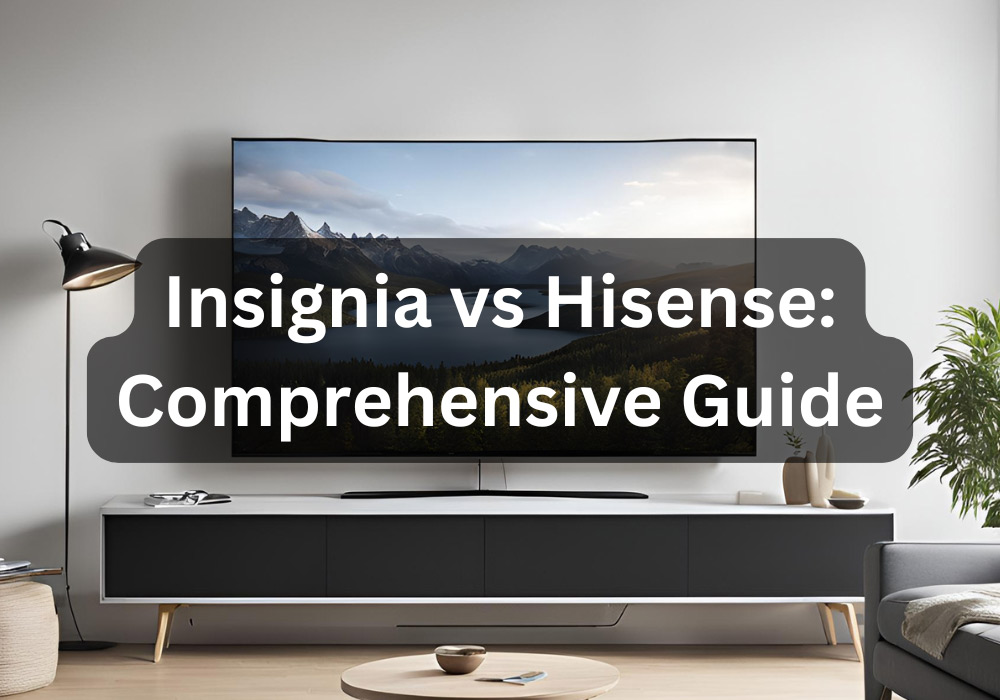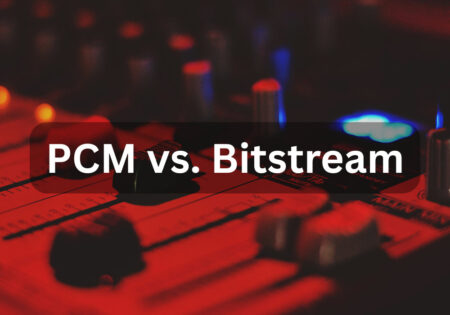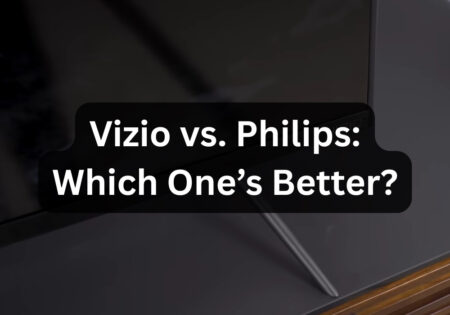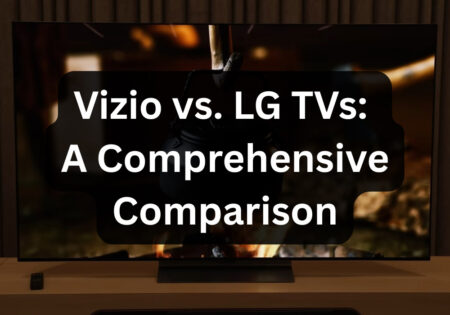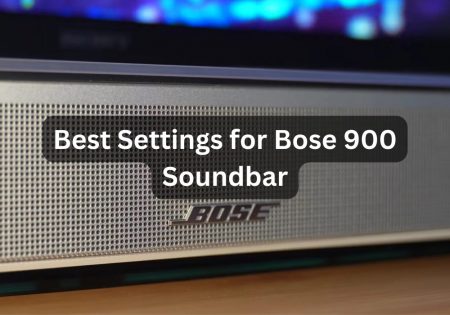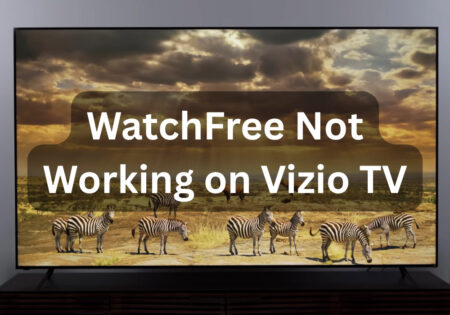Comparing Insignia vs. Hisense helps those who seek better value for money in a budget or mid-range TV brand make a better decision. That’s why I’ve written this comprehensive guide to compare some of the top models from both brands in every price range, to give you a better idea of which brand’s products are made for you. We’ll compare them in terms of picture quality, gaming performance, sound, smart features, and more. Let’s get started.
Which is the better TV, Hisense or Insignia? (Quick Answer)
Hisense TVs, while generally pricier than Insignia TVs, provide better value for money. Their TVs offer superior picture quality with ULED panels and Quantum Dot technology, which Insignia TVs can’t match in terms of color accuracy and contrast. Additionally, Hisense TVs have better gaming features like VRR. Plus, they mostly come with Google TV as their main smart platform, which is more intuitive than Insignia’s Fire TV.
Also Read:
Insignia vs Vizio
Here’s a table for you to compare Insignia vs Hisense at a glance:
| Category | Insignia | Hisense |
|---|---|---|
| Brand Overview | Budget-friendly, sold primarily at Best Buy. Basic picture quality and smart features through Fire TV integration. | Feature-rich, budget-friendly to premium models. Uses advanced technologies like ULED and Quantum Dot. Primarily uses Google TV platform. |
| Picture Quality | Basic LED technology in budget models. F50 Series uses QLED for better color reproduction but lacks advanced technologies like local dimming. | ULED and Quantum Dot technologies enhance color accuracy, brightness, and contrast. Mini-LED in mid-range models offers deeper blacks and brighter highlights. |
| Gaming Performance | No VRR support, limited to 60Hz refresh rate. Low input lag, especially in budget models. | Better gaming features with VRR support, 120Hz refresh rate in mid-range models, and lower input lag for smoother gaming. |
| Sound Quality | Basic speakers, clear at low volumes but compresses at high volumes. Lacks strong bass. | Similar basic speaker performance, but still requires external sound solutions like soundbars for better audio. |
| Smart Features | Amazon Fire TV platform, easy to use but cluttered with ads. Integrated with Alexa. Limited app support compared to Google TV. | Google TV platform, more intuitive with fewer ads, supports Chromecast, integrates well with Google Assistant, and offers a larger app selection through the Google Play Store. |
| Connectivity | Standard options: HDMI, USB, Ethernet, and audio out. | Similar standard options, with HDMI eARC for soundbars and USB ports. |
| Design & Build Quality | Thicker bezels, plastic build focusing on affordability. | Thinner bezels and more modern designs, especially in mid-range models. More durable materials like metal components in higher models. |
| Warranty & Support | 1-year warranty, typically through Best Buy. Convenient in-person support. | 2 to 3 years warranty on some models, offering better coverage and longer support duration. |
| Price Range | More affordable, focusing on budget-conscious buyers. | Slightly more expensive but offers better value for the price with advanced features. |
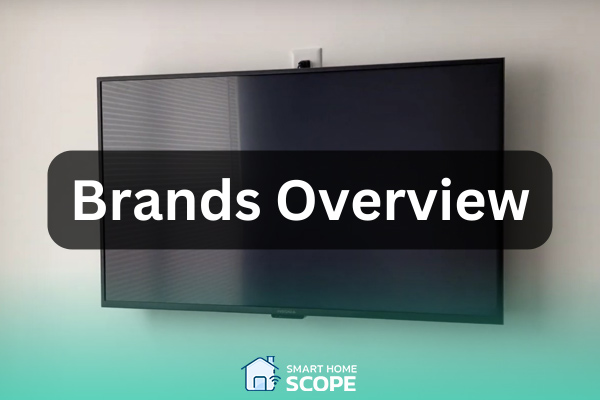
Brands Overview
Overview of Insignia TVs
Insignia is a brand known for manufacturing budget-friendly TVs that are primarily sold at Best Buy. While their TVs aren’t equipped with advanced technologies like OLED or Quantum Dot, they won’t disappoint users who seek basic picture quality for everyday use. They also provide good smart features thanks to the integration of the Fire TV platform, providing robust streaming options. If you’re really into Insignia, I suggest you read my Insignia TV review article.
Also Read:
Insignia vs TCL
Overview of Hisense TVs
Hisense is the best brand when it comes to feature-rich, budget-friendly TVs. They offer a wide range of TVs for everyone, from people on a tight budget to those who want a premium TV. Their Hisense U6K is practically the best budget TV I’ve ever tested.
Unlike Insignia, Hisense uses advanced technologies that are usually found in more expensive brands. For instance, they use advanced display technologies like ULED and Quantum Dot, which enhance color accuracy, brightness, and contrast. Plus, Hisense TVs usually come with the Google (Android) platform, which is also intuitive and full of features.
I’ve compared Hisense with Vizio as well, if you’re also interested in Vizio TVs, please refer to my Vizio vs. Hisense guide.
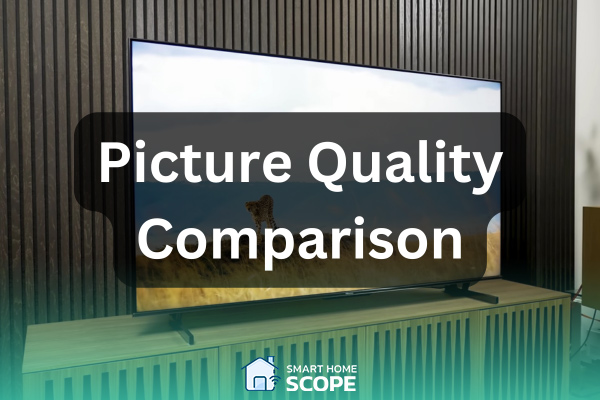
Insignia vs. Hisense: Picture Quality
First things first, it’s time to compare Insignia vs. Hisense in terms of picture quality. I’ll compare some of the best smart tv models from these two brands in two price classes: budget class and mid-range class. This helps you get to know some top models from each brand in a specific price category and compare them head-to-head.
Insignia F30 Series vs. Hisense U6K Series: Budget Picture Quality
The Insignia F30 Series comes with basic LED technology, which can deliver sharp 4K displays. Meanwhile, Hisense uses ULED technology, which is their term for enhanced LED displays. This technology adds layers of processing to improve contrast, color, and brightness.
Picture quality is where the F30 falls behind the Hisense U6K. While the color accuracy of the F30 is decent and the colors look quite life-like, it can’t match the U6K. Additionally, the F30 struggles with contrast; black levels appear more grayish, while the U6K can display deeper blacks and brighter highlights simultaneously. This is due to Hisense’s local dimming feature that adjusts the backlight in different areas of the screen.
Both TVs face challenges when viewed from extreme angles, but Hisense performs slightly better thanks to its higher brightness levels.
While often carrying a higher price tag, Hisense TVs offer remarkable value, delivering exquisite visual clarity through cutting-edge ULED panels and vibrant Quantum Dot technology
Insignia F50 QLED Series vs Hisense U7K Series: Mid-range Picture Quality
Both brands bring better quality to the competition with their mid-range models, but Hisense is still the winner. The F50 Series comes with QLED technology, which uses Quantum Dots to enhance color reproduction. On the other hand, the U7K Series offers the same ULED enhancement along with Mini-LED backlighting. The Mini-LED technology does a great job in delivering even more precise contrast and brightness by allowing better control over dimming zones.
Both Hisense and Insignia are capable of delivering lifelike, accurate colors, although the U7K Series does this better, and obviously, the technologies I just talked about are the reason for that. Don’t get me wrong, the F50 Series handles HDR content well and is great with color and contrast, but from what I saw, with the U7K you get deeper blacks and more striking highlights, especially in HDR content.
Again, when it comes to viewing angles, both the F50 and U7K perform better than their predecessors, but the U7K is more reliable in well-lit rooms since its Mini-LED technology allows it to reach higher peak brightness.
Also Read:
Onn TV Review
So, Which Brand Provides Better Picture Quality?
Insignia is a solid choice for basic TV watching, but if you seek more than just basic, Hisense’s displays are the better option.
Gaming Performance Comparison
Alright, now it’s time to see how these two brands compare when it comes to satisfying gamers.
If you’re like me, you already know how much the picture quality of a TV impacts your gaming experience. For example, playing a game like The Last of Us, which has lots of dark scenes along with colorful graphics, requires a TV with enhanced contrast and color accuracy. Since we’ve already covered picture quality, we’re going to look at other features that impact gaming experience, including input lag, refresh rate, and VRR support.
Insignia vs Hisense: Refresh Rate and VRR
Refresh rate is a number measured in Hertz (Hz), which tells how many times per second the image on the screen is refreshed. To put it in simple words, the higher the refresh rate, the smoother the motion. VRR, short for Variable Refresh Rate, adjusts the refresh rate of the screen to match the game’s frame rate. This feature can also play a pivotal role in delivering a smooth gaming experience.
Between the Insignia F30 Series and Hisense U6K, Hisense’s TVs take the lead here. Both offer a 60Hz refresh rate, which is pretty basic, but only the U6K offers a basic VRR feature that, while not as effective as what you see in higher-end models, still enhances the experience.
Stepping into the mid-range class, I was disappointed to see that the Insignia F50 only supports 60Hz, and there’s no VRR. On the other hand, the U7K offers more interesting specs here. This series provides a 120Hz refresh rate along with VRR support, which means that you’ll get a smoother experience. But I repeat, you can’t expect what you see on high-end TVs from the Hisense U7K series.
Hisense surpasses Insignia with the U6K’s VRR capability and the U7K’s 120Hz refresh rate, while Insignia lags behind, constrained to 60Hz without VRR enhancements
Insignia vs Hisense: Input Lag
Input lag simply refers to the delay between pressing a button on your gaming controller and seeing the action happen on the screen.
Our budget nominees, F30 and U6K, are both impressive with their low input lags. The U6K Series provides input lag of 11.5ms in Game Mode at 4K/60Hz, while the F30 series has an even lower input lag of 10.3ms in Game Mode at 4K/60Hz.
The mid-range contenders, Insignia’s F50 and Hisense’s U7K, continue to shine with extremely low input lags. The F50 Series offers an input lag of 10ms at 4K/60Hz, and the Hisense U7K has an input lag of 14.3ms at 4K/60Hz. But here’s the interesting part: the U7K series provided an input lag of 5.4ms when set at 4K/120Hz, meaning you can get a smoother gaming experience with an incredibly low input lag with the Hisense U7K TVs.
So, Which Brand Provides Better Gaming Experience?
Hisense beats Insignia in both budget and mid-range classes with its U6K and U7K Series, offering VRR, better refresh rate, and superior input lag.
Hisense vs Insignia: Sound Quality
Sound quality isn’t something you should mainly count on with a TV, and this holds true for both Insignia and Hisense. Both brands equip their TVs with speakers that handle dialogue well, especially at lower volumes. However, there are signs of compression at higher volumes, making dialogue less clear when the volume is maxed out.
Like most TV speakers, you can’t expect much bass from either brand. It’s always best to invest in a soundbar if you’re watching something beyond dialogue-heavy content. Action movies, gaming, and music are all areas where these TV speakers just won’t cut it.
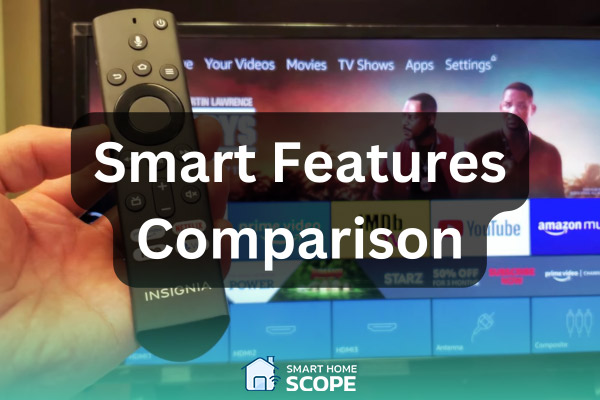
Smart Features Comparison
If you’re into smart homes like I am, you’ll appreciate having good smart features on your TV. Let’s see how these two brands compare.
Operating System and User Interface
Insignia TVs come with Amazon Fire TV as their smart platform. Fire TV is easy to use, but the ads and recommendations make the interface feel a bit cluttered. One strength is the integration with Amazon Alexa, letting you control your TV with voice commands, which is useful if you’re already using Alexa devices at home.
Hisense, on the other hand, uses the Google TV platform (formerly Android TV). While it also has ads, Google TV feels more intuitive and user-friendly, plus it offers more customization. Google TV supports Chromecast, letting you stream content directly from your Android phone to the TV, which is a bonus compared to Fire TV.
Google TV integrates with Google Assistant, making it the better choice for Google fans and those who have other Google smart devices at home.
App Availability
Both platforms give you access to the most popular streaming apps, like Netflix, Hulu, Amazon Prime Video, and Disney+. However, Google TV has a slight advantage here since you also get access to a vast library of apps and games through the Google Play Store—something Fire TV doesn’t offer.
Which Brand Wins in Smart Features?
Both platforms are easy to use, but Fire TV’s ads can take up a lot of screen space, which can be annoying. Also, Google TV’s app support through the Play Store is an added bonus. So, the winner is Hisense. However, if you already have a lot of Alexa devices, Insignia’s Fire TV might be better for you since it integrates smoothly with Alexa.
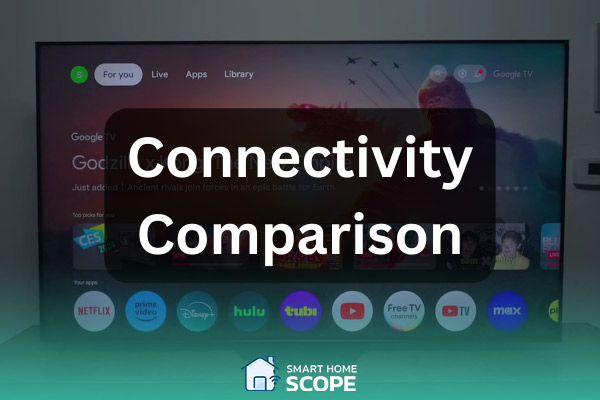
Connectivity Comparison
It’s important for your TV to have multiple connectivity options for external devices. Both brands offer options like HDMI eARC for soundbars, USB ports, Ethernet for wired internet, and a 3.5mm analog audio out.
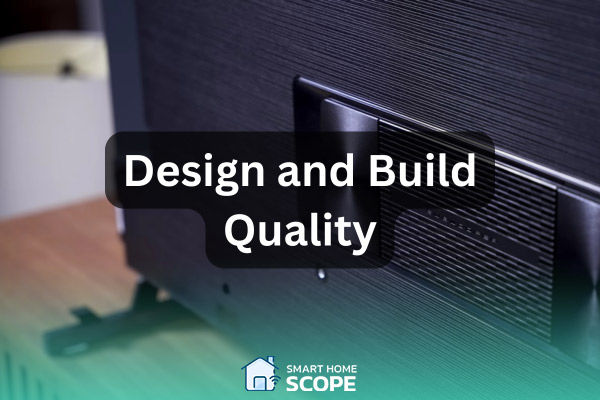
Design and Build Quality
Hisense TVs, especially their mid-range and premium models like the U7K Series, offer a more modern design with thinner bezels and more durable metal components. On the other hand, Insignia TVs, like the F30 and F50 Series, focus more on affordability, which means they have thicker bezels and mostly plastic components. So, if design and build quality matter to you, Hisense is the better option.
Customer Support and Warranty
Insignia offers a standard 1-year warranty through retailers like Best Buy. This is convenient if you prefer in-person help or easy returns. Hisense, on the other hand, typically offers a better warranty—usually 2 years, and in some cases, up to 3 years on select models.
Conclusion
Both Insignia and Hisense are known as budget-friendly brands, but Hisense is usually a bit more expensive. However, as you’ve seen in this comparison, Hisense offers better value for money with superior picture quality, gaming performance, smart features, and build quality. Hopefully, this guide has helped you decide which brand suits your needs best.
FAQs
Are Hisense TVs Better than Insignia?
Yes, Hisense TVs are generally better than Insignia. For example, comparing Hisense’s U6K Series with Insignia’s F30 Series, Hisense delivers better picture quality, smart features, and gaming performance.
Is Insignia a Good TV Brand?
Insignia offers valuable features for budget-conscious buyers. However, they’re not the best choice for serious movie enthusiasts or gamers.
Is Hisense a High-End Brand?
No, Hisense isn’t a high-end brand, but they do offer competitive mid-range TVs with impressive features. You could call Hisense the king of budget-friendly TV brands.
Who Actually Makes Insignia TVs?
Insignia TVs are made by Sharp and sold under the Insignia brand, which is owned by Best Buy.
